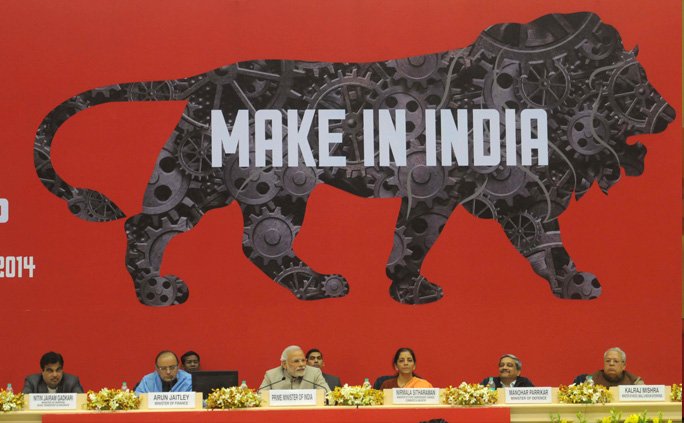India has seen a spree of new policies and welfare schemes emerging in the last four years. Make In India is one of the most prominent and ambitious policies which was bought by the newly established Modi Government in September 2014.
The prime goal of this policy is to make India a global manufacturing hub by inviting and encouraging both multinational and national companies to manufacture their products in India.
Make in India has introduced a manifold of new initiatives for encouraging FDI (foreign direct investment), applying intellectual property rights and accelerating the manufacturing sector.
The policy has been focusing on the 25 sectors of the economy like Automobile, Information Technology (IT), Business Process Management (BPM), etc. Other than boosting the manufacturing sector, it also seeks to facilitate job creation, trigger innovation, evolve skill development and shield intellectual property.
The perception behind this policy can be determined from its logo which has a lion made of gear wheels reflecting the vital role of manufacturing in India’s national development.
This article tries to take an overview of how the ambitious policy Make in India has worked for India including its benefits and its overall impact on the country.
Background
Before going ahead, we need to look at the backdrop to understand the reasons behind formulating this policy. In the last decade, India had focused more on the service sector than the manufacturing sector. Because of that, the manufacturing sector’s share in the economy had shrunk and could contribute only 15-16% to the GDP. It was evident that if any country wishes to be a developed nation, it needs to accelerate its manufacturing sector. This is the reason why the government decided to bring in a policy to boost manufacturing. To fulfill its goals, this policy stands on four pillars:
1. New developments;
2. New infrastructure;
3. New sectors;
4. New outlook.
Advantages of ‘Make In India’
- The policy seeks to develop a labor-intensive manufacturing sector. This has helped in creating new job opportunities in India in the manufacturing sector. It is expected to generate 100 million new jobs by the year 2022.
- The growth in employment is adjacent to the growth of purchasing power of an individual. Hence, this policy is also beneficial for the reduction of poverty and underdevelopment.
- This policy is highly advantageous for achieving the goals National Manufacturing Policy as it aims at boosting the share of the manufacturing sector to 25% of the GDP.
- Make in India is a phenomenal booster for the ‘Look East Policy’ for all the nations. By inviting all the countries to ‘make’ in India, India has also strengthened the ties with other countries.
- Export-oriented growth model improves the Foreign Direct Investment which is very important for heightening a nation’s position in global economy.
- Under this policy, the government has ensured an auto response mechanism through which procedural questions and issues will be resolved in a specified time frame. This step is very crucial for lessening delay and creating an industry-friendly mechanism.
- Along with the foreign investment, technical expertise and creative skills will also flow into India from other countries which will help Indians enhance their skill set and gain excellence with global standards.
Impact of ‘Make In India’
‘Zero defect, zero effect’ is the benchmark of Make in India campaign. It calls for producing a product with ‘zero defect’ and ‘zero effect’ on our environment. This is a promise for sustainable development in the country.
Elaborating on the impact of Make in India as a policy, one can say that within such a small span of time, the initiative has fostered many success stories.
- In December 2015, Micromax proclaimed that it would establish three new manufacturing units in Rajasthan, Telangana and Andhra Pradesh.
- Japan announced funding of USD 12 billion for Make in India projects.
- Huawei inaugurated a new Research and Development (R&D) campus in Bengaluru and also plans to set up a telecom hardware manufacturing plant in Chennai.
- France-based LH Aviation signed a Memorandum of Understanding (MoU) with OIS Advanced Technologies to set up a manufacturing facility in India for producing drones.
- Foxconn announced it would invest USD 5 billion over five years for R&D and creating a hi-tech semiconductor manufacturing facility in Maharashtra.
- Samsung will be making its Samsung Z1 in Noida, and General Motors declared an investment of USD 1 billion to producing automobiles in Delhi.
From these fruitful instances, one can surely say that the policy is working towards the upward development of the country. “Come, Make in India! Sell anywhere, but Make in India.” was the call given to the world while introducing this policy and the world seems to have received the invitation very well!
We at Deshpee Group are also inspired by this spirit of innovation and look forward towards contributing to it with our group of companies 100% ‘made in India’.
Image by PM Narendra Modi on Flickr








